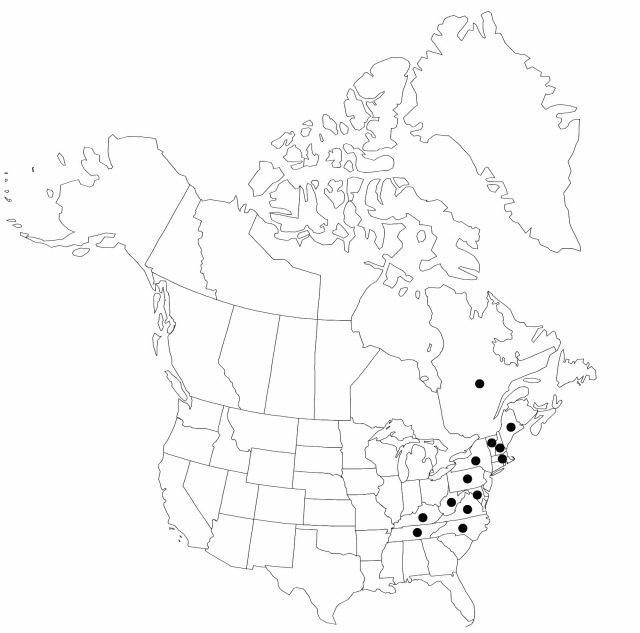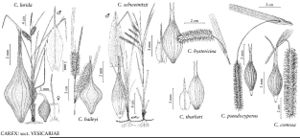Difference between revisions of "Carex baileyi"
Bull. Torrey Bot. Club 22: 220. 1895.
FNA>Volume Importer |
FNA>Volume Importer |
||
| Line 27: | Line 27: | ||
|elevation=200–1200 m | |elevation=200–1200 m | ||
|distribution=Que.;Ky.;Maine;Md.;Mass.;N.H.;N.Y.;N.C.;Pa.;Tenn.;Vt.;Va.;W.Va. | |distribution=Que.;Ky.;Maine;Md.;Mass.;N.H.;N.Y.;N.C.;Pa.;Tenn.;Vt.;Va.;W.Va. | ||
| − | |discussion=<p>Carex baileyi, a taxon confined to the Appalachian Mountain region, is very similar in appearance to C. lurida; however, it is more delicate with narrower leaves and spikes and has proportionally longer and more abruptly beaked perigynia.</p> | + | |discussion=<p><i>Carex baileyi</i>, a taxon confined to the Appalachian Mountain region, is very similar in appearance to <i>C. lurida</i>; however, it is more delicate with narrower leaves and spikes and has proportionally longer and more abruptly beaked perigynia.</p> |
|tables= | |tables= | ||
|references= | |references= | ||
| Line 51: | Line 51: | ||
|publication year=1895 | |publication year=1895 | ||
|special status= | |special status= | ||
| − | |source xml=https://jpend@bitbucket.org/aafc-mbb/fna-data-curation.git/src/ | + | |source xml=https://jpend@bitbucket.org/aafc-mbb/fna-data-curation.git/src/8f726806613d60c220dc4493de13607dd3150896/coarse_grained_fna_xml/V23/V23_947.xml |
|genus=Carex | |genus=Carex | ||
|section=Carex sect. Vesicariae | |section=Carex sect. Vesicariae | ||
Revision as of 16:12, 18 September 2019
Plants densely to loosely cespitose; rhizomes short, no more than 10 cm. Culms sharply trigonous in cross section, 20–65 cm, scabrous-angled distally. Leaves: basal sheaths reddish purple; ligules as long as to longer than wide; blades dark green, flat to W-shaped, widest leaves 2.4–4(–5) mm wide, glabrous. Inflorescences 3–16(–22) cm; proximal bract 12–40(–55) cm, greatly exceeding inflorescence; proximal 1–2(–3) spikes pistillate, proximal spreading to pendent, the distal erect, 9–14(–15) mm thick, 2.5–3.5 times as long as wide; terminal 1 spike staminate. Pistillate scales narrowly oblong, 2.9–9.8 × 0.3–0.9 mm, as long as or shorter than perigynia, margins often ciliate, apex truncate to retuse, erose and prolonged into a scabrous awn. Staminate scales scabrous-awned, sometimes ciliate-margined. Perigynia ascending to spreading, strongly 5–9-veined, veins separate nearly to beak apex, broadly ovate to nearly orbiculate, 4.8–6.5(–7.6) × 1.8–2.7 mm, apex abruptly contracted; beak 2.2–4 mm, 0.7–1.3 length of body, bidentulate, smooth, teeth straight, 0.1–0.6 mm. Stigmas 3. Achenes brown, trigonous, papillose.
Phenology: Fruiting Jun–Aug.
Habitat: Sandy, peaty, or gravelly pond, lake, and stream shores, sedge meadows, open swamps, seeps, ditches, usually in acidic soils
Elevation: 200–1200 m
Distribution

Que., Ky., Maine, Md., Mass., N.H., N.Y., N.C., Pa., Tenn., Vt., Va., W.Va.
Discussion
Carex baileyi, a taxon confined to the Appalachian Mountain region, is very similar in appearance to C. lurida; however, it is more delicate with narrower leaves and spikes and has proportionally longer and more abruptly beaked perigynia.
Selected References
None.
